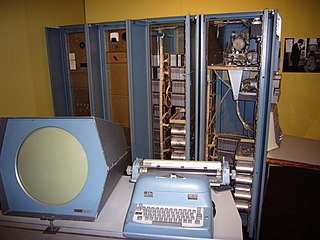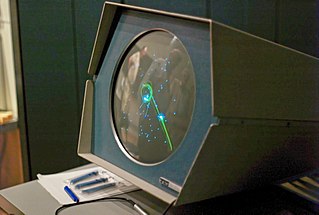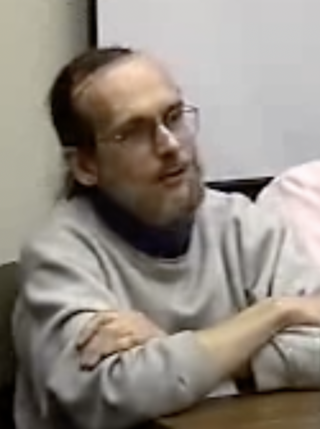
Programmed Data Processor (PDP), referred to by some customers, media and authors as "Programmable Data Processor," is a term used by the Digital Equipment Corporation from 1957 to 1990 for several lines of minicomputers.

The PDP-1 is the first computer in Digital Equipment Corporation's PDP series and was first produced in 1959. It is famous for being the most important computer in the creation of hacker culture at the Massachusetts Institute of Technology, Bolt, Beranek and Newman and elsewhere. The PDP-1 is the original hardware for playing history's first game on a minicomputer, Steve Russell's Spacewar!
TECO, short for Text Editor & Corrector, is both a character-oriented text editor and a programming language, that was developed in 1962 for use on Digital Equipment Corporation computers, and has since become available on PCs and Unix. Dan Murphy developed TECO while a student at the Massachusetts Institute of Technology (MIT).

A word processor is an electronic device for text, composing, editing, formatting, and printing.
In computing, a line editor is a text editor in which each editing command applies to one or more complete lines of text designated by the user. Line editors predate screen-based text editors and originated in an era when a computer operator typically interacted with a teleprinter, with no video display, and no ability to move a cursor interactively within a document. Line editors were also a feature of many home computers, avoiding the need for a more memory-intensive full-screen editor.
TYPSET is an early document editor that was used with the 1964-released RUNOFF program, one of the earliest text formatting programs to see significant use.

The PDP-6, short for Programmed Data Processor model 6, is a computer developed by Digital Equipment Corporation (DEC) during 1963 and first delivered in the summer of 1964. It was an expansion of DEC's existing 18-bit systems to use a 36-bit data word, which was at that time a common word size for large machines like IBM mainframes. The system was constructed using the same germanium transistor-based System Module layout as DEC's earlier machines, like the PDP-1 and PDP-4.

The Friden Flexowriter produced by the Friden Calculating Machine Company, was a teleprinter, a heavy-duty electric typewriter capable of being driven not only by a human typing, but also automatically by several methods, including direct attachment to a computer and by use of paper tape.
Daniel L. Murphy is an American computer scientist notable for his involvement in the development of TECO, the operating systems TENEX and TOPS-20, and email.

Alan Kotok was an American computer scientist known for his work at Digital Equipment Corporation and at the World Wide Web Consortium (W3C). Steven Levy, in his book Hackers: Heroes of the Computer Revolution, describes Kotok and his classmates at the Massachusetts Institute of Technology (MIT) as the first true hackers.

Spacewar! is a space combat video game developed in 1962 by Steve Russell in collaboration with Martin Graetz, Wayne Wiitanen, Bob Saunders, Steve Piner, and others. It was written for the newly installed DEC PDP-1 minicomputer at the Massachusetts Institute of Technology. After its initial creation, Spacewar! was expanded further by other students and employees of universities in the area, including Dan Edwards and Peter Samson. It was also spread to many of the few dozen installations of the PDP-1 computer, making Spacewar! the first known video game to be played at multiple computer installations.

TJ-2 was published by Peter Samson in May 1963 and is thought to be the first page layout program. Although it lacks page numbering, page headers and footers, TJ-2 is the first word processor to provide a number of essential typographic alignment and automatic typesetting features:

Expensive Desk Calculator by Robert A. Wagner is thought to be computing's first interactive calculation program.

Colossal Typewriter by John McCarthy and Roland Silver was one of the earliest computer text editors. The program ran on the PDP-1 at Bolt, Beranek and Newman (BBN) by December 1960.
Expensive Tape Recorder is a digital audio program written by David Gross while a student at the Massachusetts Institute of Technology. Gross developed the idea with Alan Kotok, a fellow member of the Tech Model Railroad Club. The recorder and playback system ran in the late 1950s or early 1960s on MIT's TX-0 computer on loan from Lincoln Laboratory.
Harmony Compiler was written by Peter Samson at the Massachusetts Institute of Technology (MIT). The compiler was designed to encode music for the PDP-1 and built on an earlier program Samson wrote for the TX-0 computer.
BATCH-11/DOS-11, also known simply as DOS-11, is a discontinued operating system by Digital Equipment Corporation (DEC) of Maynard, Massachusetts. The first version of DOS-11 (V08-02) was released in 1970 and was the first operating system to run on the Digital PDP-11 minicomputer. DOS-11 was not known to be easy to use even in its day and became much less used in 1973 with the release of the RT-11 operating system.

David A. Moon is a programmer and computer scientist, known for his work on the Lisp programming language, as co-author of the Emacs text editor, as the inventor of ephemeral garbage collection, and as one of the designers of the Dylan programming language. Guy L. Steele Jr. and Richard P. Gabriel (1993) name him as a leader of the Common Lisp movement and describe him as "a seductively powerful thinker, quiet and often insulting, whose arguments are almost impossible to refute".
BASIC-8, is a BASIC programming language for the Digital Equipment (DEC) PDP-8 series minicomputers. It was the first BASIC dialect released by the company, and its success led DEC to produce new BASICs for its future machines, notably BASIC-PLUS for the PDP-11 series. DEC's adoption of BASIC cemented the use of the language as the standard educational and utility programming language of its era, which combined with its small system requirements, made BASIC the major language during the launch of microcomputers in the mid-1970s.









